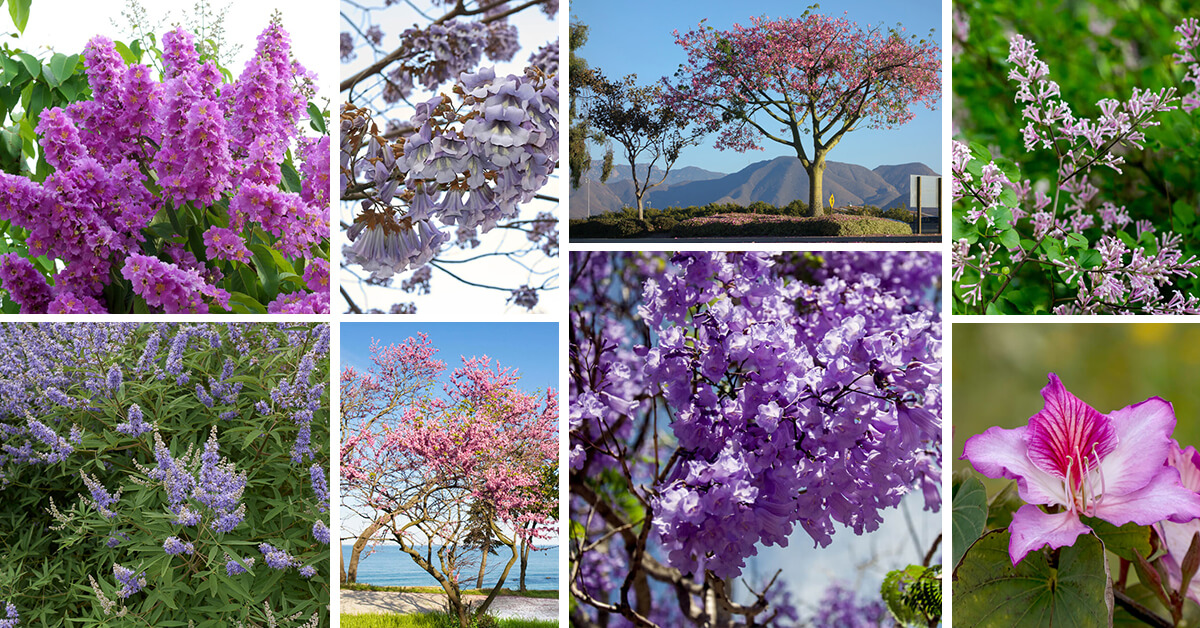Trees with purple flowers will give any garden a regal and magical appeal.
A splash of purple is simply majestic. It’s one reason why popular culture uses purple to portray magic. Trees blooming in shades of purple will bring that majestic feel to your garden, beautifully coloring the space and making it soothing.
But what trees should you go for when planning to add an amazing splash of purple to your garden? This article will answer this question.
We’ll examine 13 trees with spectacular purple flowers. At the end of this article, you’ll know what purple flowering tree is perfect for you to turn your garden into a majestic and restful place.
Key takeaways
- Most of the trees with purple flowers bloom in late spring.
- The Jacaranda is the purple flowering tree with the most limited growing area, as it grows successfully in only USDA zones 10 and 11
- Some trees with purple flowers produce edible fruits (e.g., Purple Leaf Plum).
- Many of the purple flowering trees produce a sweet fragrance that attracts birds, and one of the most fragrant is the Fragrant Lilac.
Discover beautiful garden trees with purple flowers

1. Crape Myrtle (Lagerstroemia indica)

The Crape Myrtle is one of the showiest blooming plants in full sun. It produces dense clusters of tiny flowers in shades of lavender and purple. The crinkled flowers of the tree resemble crepe paper in texture.
Crape Myrtle is a heat-loving tree that thrives in hot summer climates. It starts blooming in late spring or early summer and continues until the first frost.
Crape Myrtle is a perfect choice for a low-maintenance flowering garden tree. It grows in sandy, loamy, and even tight clay soils and is drought-resistant once established. It grows best in USDA zone 7 to 10, but some do well in zone 6.
There are four main categories of size for Crape Myrtles – dwarf (3 to 5 feet), intermediate (5 to 10 feet), medium (10 to 20 feet), and tall (more than 20 feet). So, whatever your garden size, you’ll find a perfect Crape Myrtle for a colorful splash of purple.
2. Purple leaf plum (Prunus cerasifera)
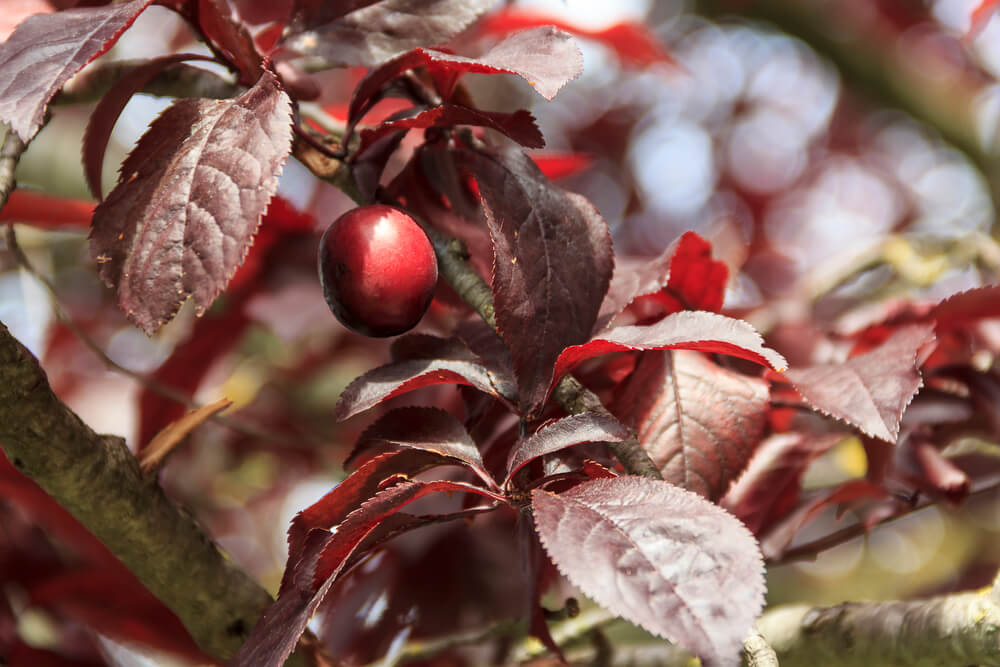
Purple leaf plum is a tree in the rose family that will add interest to your garden. First, it is a unique tree in that its leaves are not green but purple. In spring, it blossoms, producing fragrant, five-petaled white to pale pink flowers.
The Purple Leaf Plum is a moderate-size tree that grows to 15 – 25 feet, making it a good fit for most gardens.
Leaves will turn almost green in the shade. So, for the tree’s foliage to dazzle in its rich, luxuriant purple, you should plant it in full sun or only partial shade.
The Purple Leaf Plum grows best in USDA zones 4 to 9. The tree likes loamy soil and an acidic to neutral pH. But it can also tolerate clay and sandy soil. The tree requires a bit of maintenance as it needs regular weekly watering. Though the purple leaf tree is mainly grown for ornamental purposes, it produces small edible red fruits that ripen in late summer.
3. Chaste tree (Vitex agnus-castus)
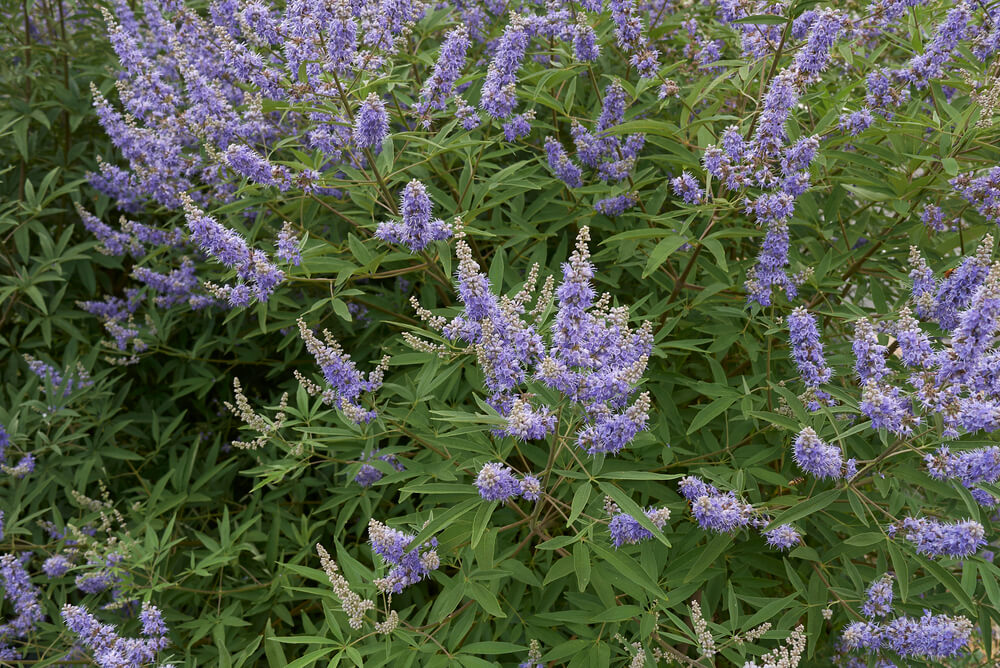
The Chaste tree is a tree-like shrub that produces striking purple flowers. The flowers follow the stem up, creating purple cones. The flowers produce an aromatic fragrance that’ll spice up your garden.
It’s a tree that medical herbalists have used as a herb for centuries. However, its dazzling and aromatic purple flower cones make it an excellent ornamental tree. Depending on pruning, the Chaste tree grows between 8 to 20 feet, making it suitable for any garden size.
Chaste trees grow well in a wide range of soils. You can grow the tree in USDA zones 5 to 9. However, in zones 5 and 6, it’ll die back to the ground in winter and bloom the following summer.
It blooms during the spring and summer and continues past late summer when other trees with beautiful purple flowers no longer bloom.
4. Eastern Redbud tree (Cercis canadensis)
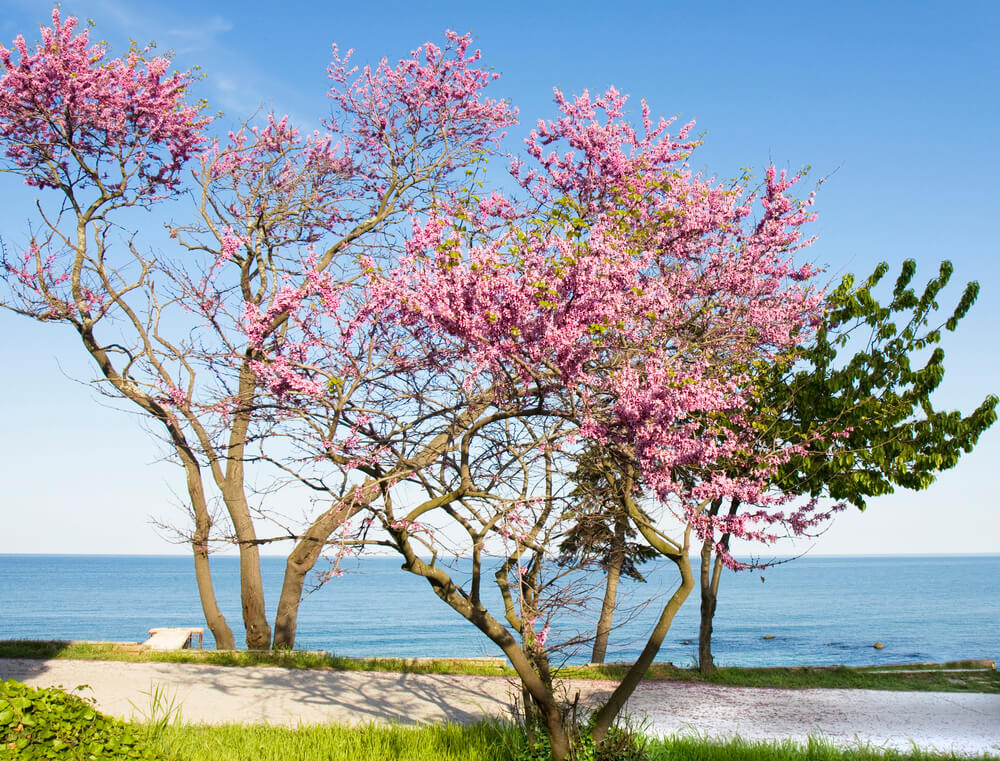
The Eastern Redbud is a dramatic tree known as the harbinger of spring. The tree creates a gorgeous display every spring. The full sun shining on the tree’s fully unfurled flowers set off a spectacular show of purple-red fireworks. Purple pods of pea-like seeds follow the bloom, adding more excitement.
Adding to the tree’s beauty is its rich burgundy heart-shaped foliage. The tree’s irregular branching pattern features a trunk that divides close to the ground, creating a full tree with rich foliage.
While the Eastern Redbud tree grows up to 30 feet, you’ll also find dwarf variants.
The trees grow successfully in USDA zones 4 to 8. They do well in every soil type. But it needs regular watering, as it is not drought-tolerant.
5. Jacaranda tree (Jacaranda mimosifolia)
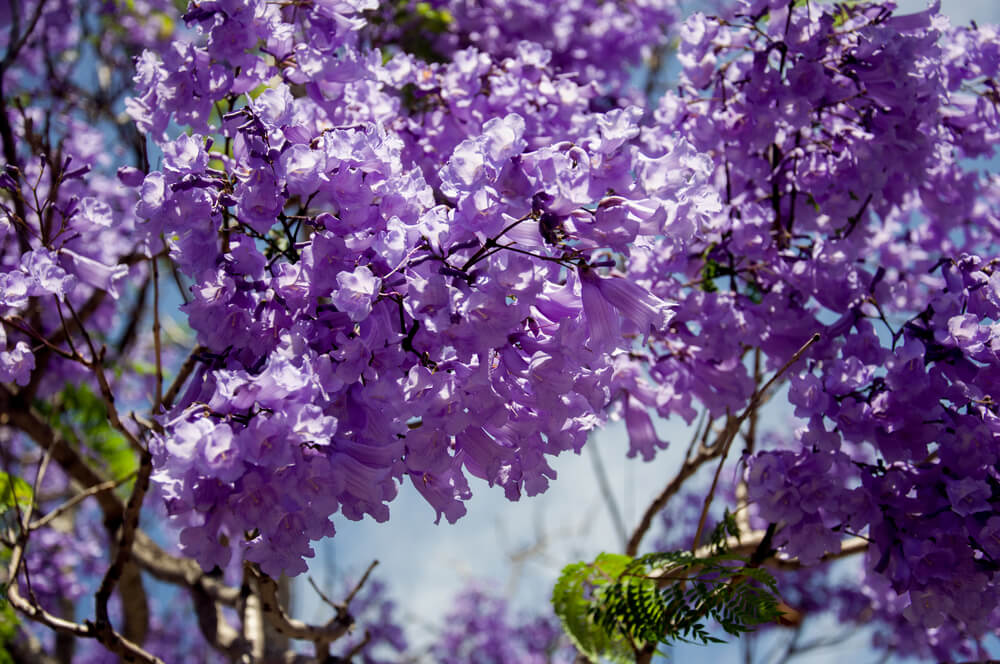
The Jacaranda tree is the aesthetic centerpiece of many landscapes, especially in Los Angeles.
The Jacaranda is a testament to nature’s artistry when it blossoms in late spring and early summer. The tree’s arching branches create a canopy of fern-like foliage crowned by its beautiful lavender-blue blossoms. Plus, the flowers are fragrant and will scent your space beautifully.
The Jacaranda tree grows best in USDA zones 10 and 11. It requires full sun (or light shade) and well-drained soil. It is a low-maintenance tree once established. The Jacaranda tree grows up to 66 feet. So, it is more suitable for bigger gardens or as a street tree.
6. Texas Mountain Laurel (Dermatophyllum Secundiflorum)
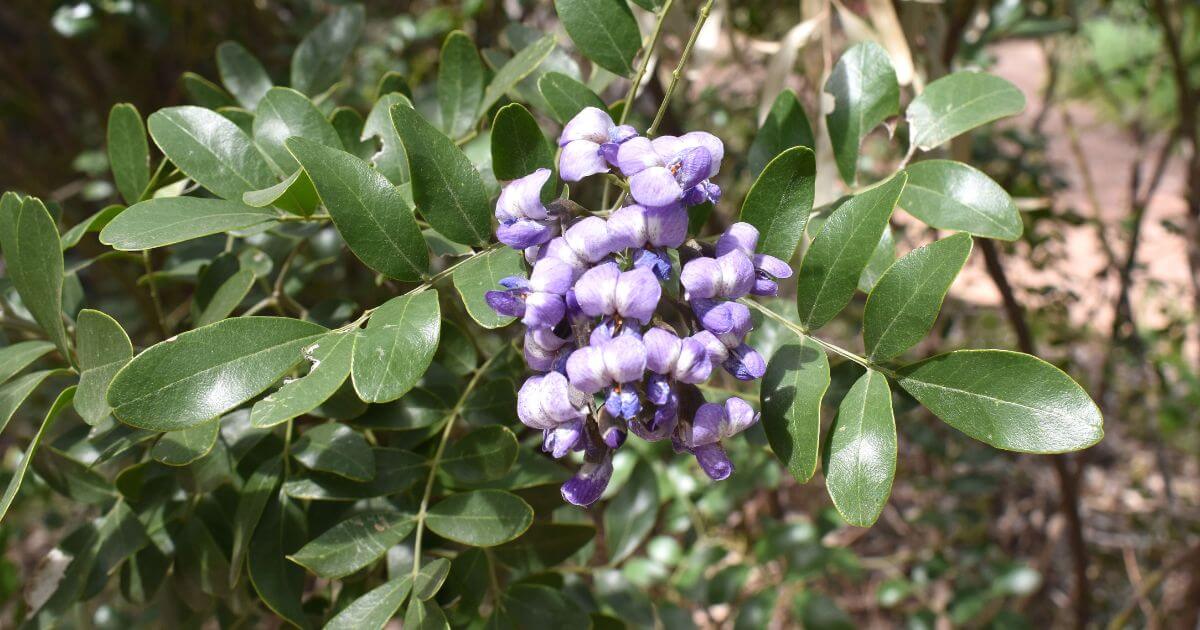
The Texas Moutain Laurel is native to the state of Texas. The tree has dense foliage of evergreen leaves and, in spring, produces beautiful clusters of purple flowers. The beautiful flower clusters can be six inches long and softly droop, resembling wisteria flowers.
The flower clusters are not only beautiful, but they also produce a sweet fragrance that can waft a considerable distance from the plant and linger in the air.
The Texas Mountain Laurel is a small tree that grows well in well-drained alkaline soils in USDA zones 7b to 11. It grows between 15 to 25 feet tall, making it a good fit for many gardens.
7. Fragrant Lilac (Syringa vulgaris)
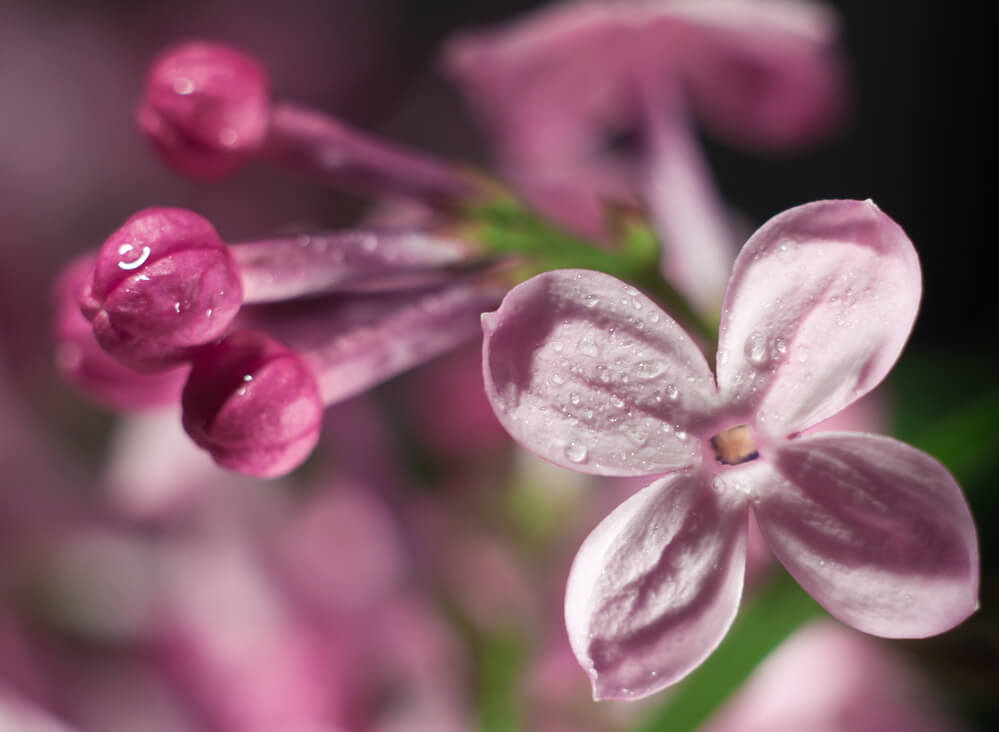
Fragrant Lilac is a multi-stemmed plant that is popular for its lilac blossom, which is extremely fragrant.
In spring and summer, the plant’s bright green foliage gives way to its aromatic trumpet-shaped blossoms, featuring lavender, purple, and lilac shades.
Syringa Vulgaris should be the go-to tree with purple flowers if you want a very fragrant garden. The strongly scented blossoms attract the first butterflies of the spring, adding more color and beauty to your space.
Fragrant Lilac is technically a shrub and not a tree. Many of these plants top out at 10 feet, making them perfect for any size garden. Importantly, Fragrant Lilac is a fairly carefree plant requiring little maintenance. It grows in well-drained soils, whether alkaline or acidic, mostly in USDA zones 3 to 7.
8. Takasago Flowering Cherry (Prunus Sieboldii)
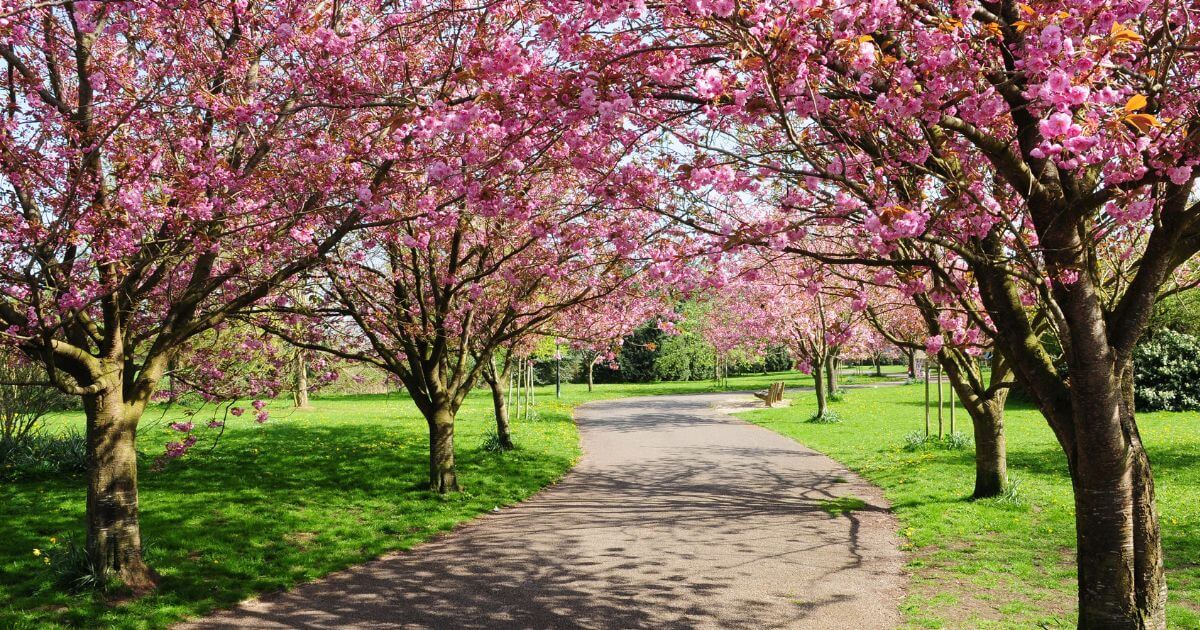
The Takasago Flowering Cherry is an important tree in Japanese culture as it represents the beauty of nature.
The tree is really beautiful in its full glory. Unlike other Japanese Cherry trees that produce white or pink blossoms, the Takasago Flowering Cherry produces luxuriant lavender purple flowers. The lightly scented flowers emerge from distinctive rose flower buds before the leaves.
The Takasago Flowering Cherry has generous branching and foliage. Though it can grow up to 20 feet, it has a low canopy about 2 feet off the ground. Thus, the rich covering of blossoms adorns the tree like a flowing, purple flowery veil.
The Takasago Flowering Cherry needs full sunlight. But it grows best in rich soils with average moisture, mainly in USDA zones 5b to 8a.
9. Royal Purple Smoke Tree (Cotinus Coggygria)
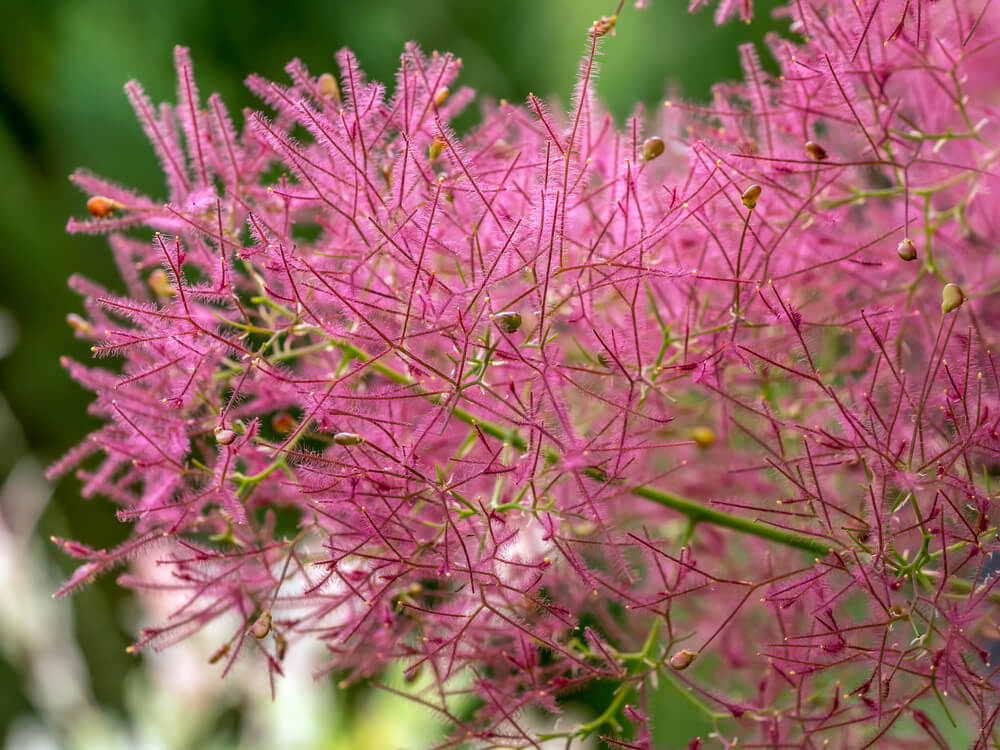
The Royal Purple Smoke Tree has a unique appearance that helps it make an impression anywhere it is planted.
The smoke tree is an ornamental tree that changes its color in autumn. Its foliage emerges in spring as a purplish-red, then becomes plum-purple all summer and into autumn.
In addition to the color dynamism of its foliage, the Royal Purple Smoke tree produces fringed smoke-like blooms that stun in a pinkish red all summer. This comes from fine hairs surrounding developing seeds.
The Royal Purple Smoke tree grows into a well-rounded plant of about 10 feet tall, making it perfect for every garden.
It is a low-maintenance tree that grows easily on virtually all soil types and has no pests or diseases. It is dought-tolerant once established. Though it requires full sunlight, it is cold-tolerant and grows successfully in USDA zones 5 – 8.
10. Silk Floss Tree (Ceiba Speciosa)
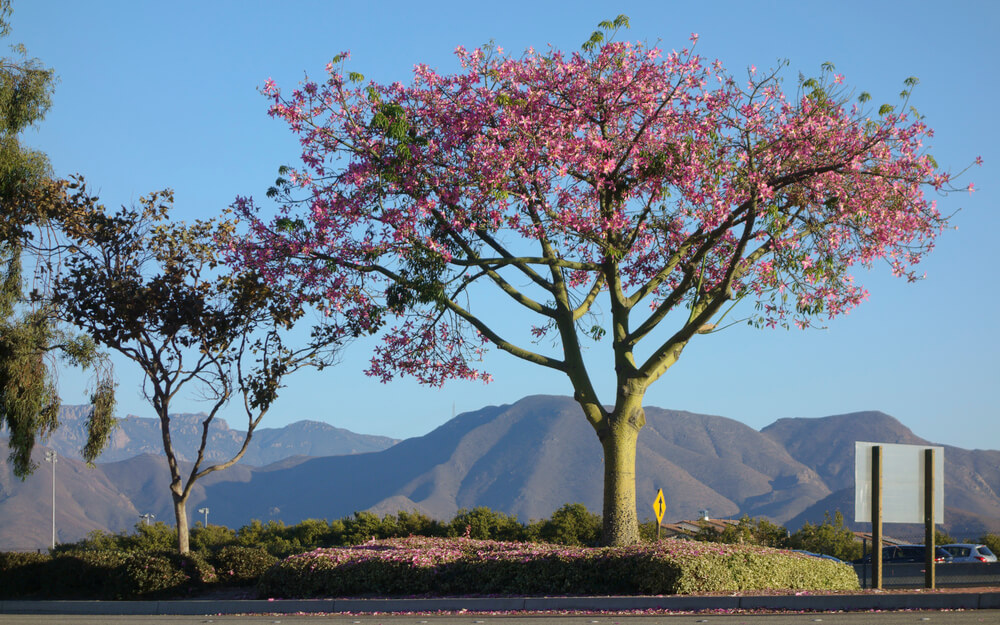
The Silk Floss tree is a deciduous tree that is native to the tropical and subtropical forests of South America. It is a weird ornamental tree that looks beautiful and dangerous at the same time.
The Silk Floss grows up to 60 feet tall and branches into an umbrella-like canopy. In the fall, the tree sheds its leaves, and a showy flowery bloom takes over, making the tree look like something from a fairy tale. The five-petal flowers are similar to Hibiscus. They are creamy-white in the center and pinkish-purple toward the tips.
However, the trunk and branches of the Silk Floss feature sharp conical prickles. This will deter wild animals from climbing the tree. But it means you’ll need to establish safety buffer zones around the tree to protect young people and domesticated animals.
Silk Floss trees are good shade trees that grow successfully in USDA zones 9 to 11. They require full sun and grow well in well-drained soil, whether acidic or alkaline. Once established, it is drought-resistant.
11. Royal Empress Tree (Paulownia Tomentosa)
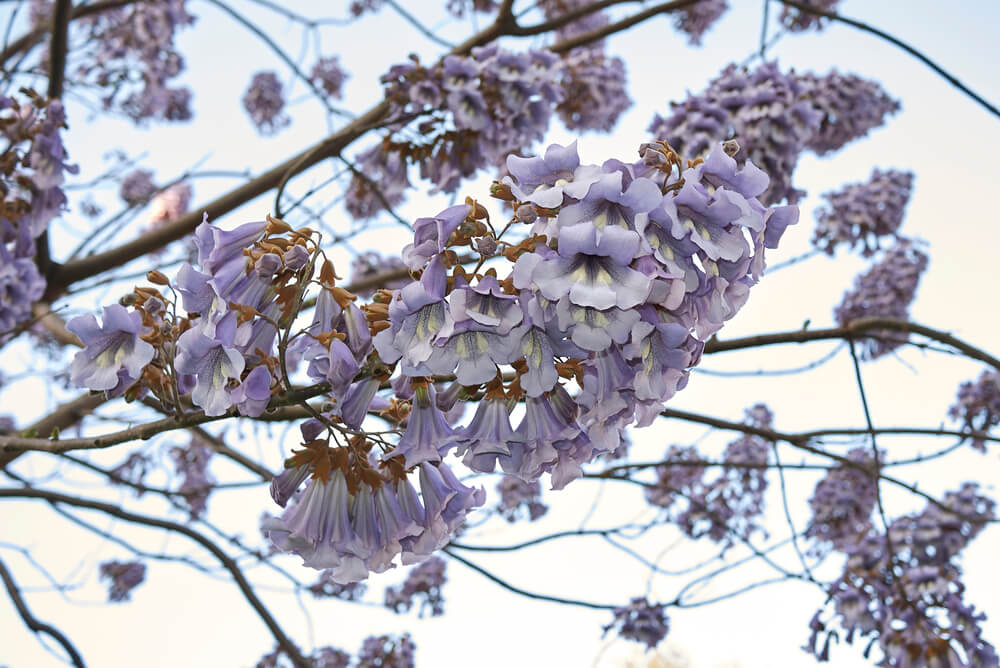
The Royal Empress tree is a deciduous fast-growing tree native to Eastern Asia. It is also known as the princess tree because it is named after the Russian princess Anna Paulowna (1795 – 1865).
The Royal Empress tree has a thick canopy of velvety green leaves and produces vanilla-scented light-purple flowers. Its large clusters of showy purple blooms make it a beautiful addition to any landscape.
It grows successfully in USDA zones 5 to 9. It thrives well on different soil types and grows easily and quickly. In fact, their rapid growth makes many jurisdictions recommend against planting them. So, before planting the princess tree with purple flowers, you should check with your local authorities.
12. Dwarf Korean Lilac (Syringa Meyeri ‘Palibin’)
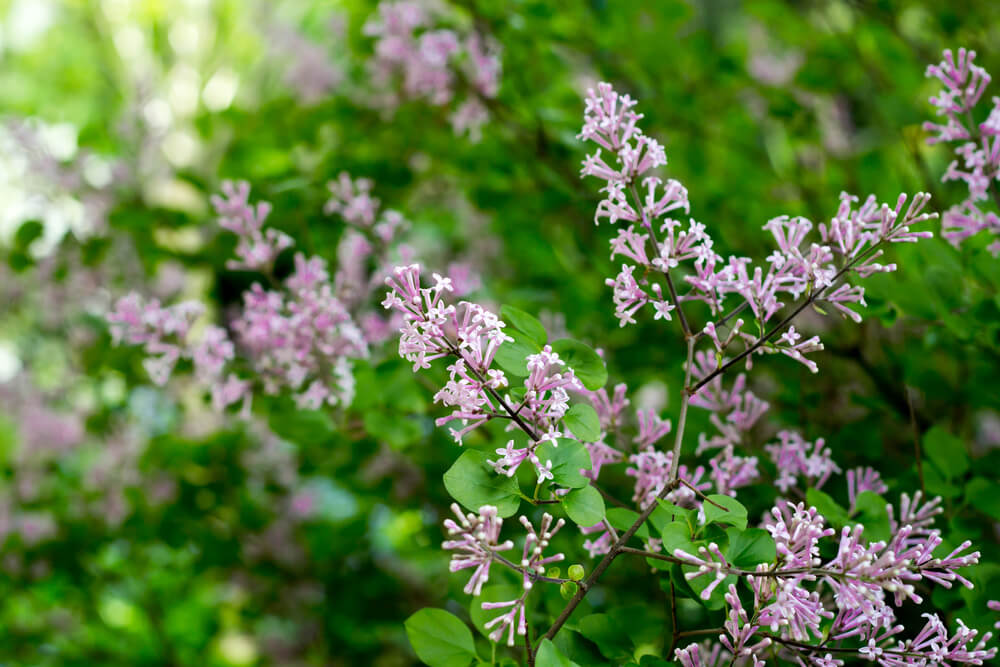
The Dwarf Korean Lilac tree is a dense deciduous dwarf tree native to Korea. It grows into a compact, rounded ball shape and produces fragrant flowers that are a mixture of lilac and purple.
When the Dwarf Korean Lilac tree blooms in the spring, stunning panicles of purple flowers emerge from distinctive violet flower buds, beautifully complementing the plant’s dark green foliage.
The Dwarf Korean Lilac grows to about 7 feet (with 4 feet spread). Its size and well-refined foliage make it a perfect solitary accent in a garden or a patio shrub.
The plant grows well in both dry and moist areas in USDA zones 3 – 7. However, it is a high-maintenance tree, requiring regular care.
13. Purple Orchid Tree (Bauhinia Purpurea)
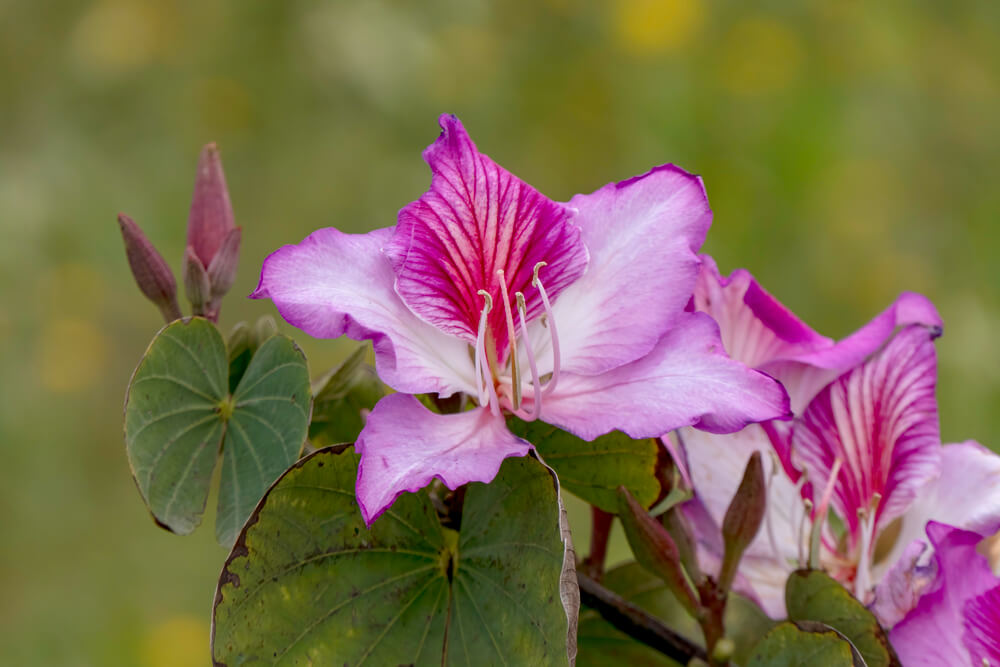
The Purple Orchid tree is a medium-sized deciduous tree also known as the butterfly tree.
The Purple Orchid lives up to its “butterfly” nickname because it produces fragrant, eye-catchy purple flowers in early fall. The colorful 5-petal flowers conspicuously stand out against the tree’s heart-shaped leaves and attract hummingbirds.
Purple Orchids grow up to 17 feet, making them perfect for almost every garden in your garden.
The tree grows successfully in USDA zones 9 to 11 and thrives on nearly all soil types. Interestingly, it is one of the few trees with beautiful purple flowers that grow well in containers indoors.
[wp-faq-schema title=”Frequently Asked Questions About trees with purple flowers” accordion=1]Purple flowering trees to spice up your garden
Trees with purple flowers are colorful trees that add excitement to your garden or landscape. While purple is not a popular color in nature, there are a number of purple flowering trees for a garden.
Depending on your location in the US and the size of your garden, you can’t go wrong with any of the thirteen purple flowering trees listed above. These include Crape Myrtle, Chaste tree, Purple Leaf Plum, Jacaranda, Eastern Redbud tree, Texas Mountain Laurel, Flagrant Lilac, Royal Empress tree, Purple Orchid tree, etc.

